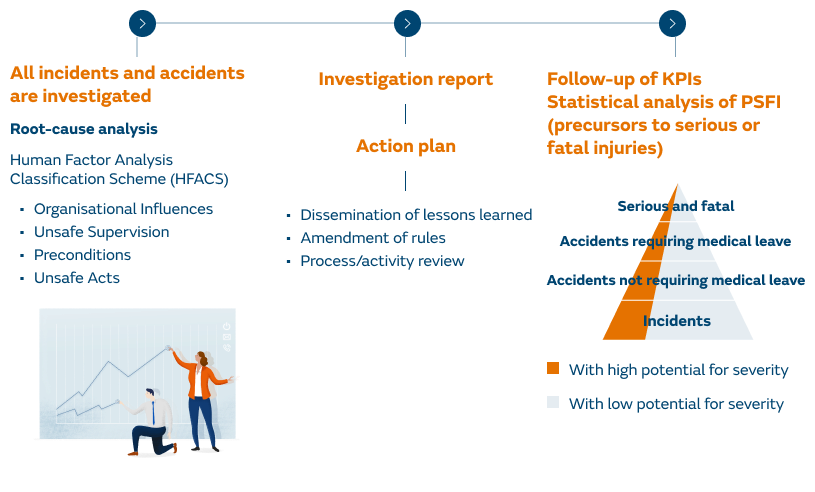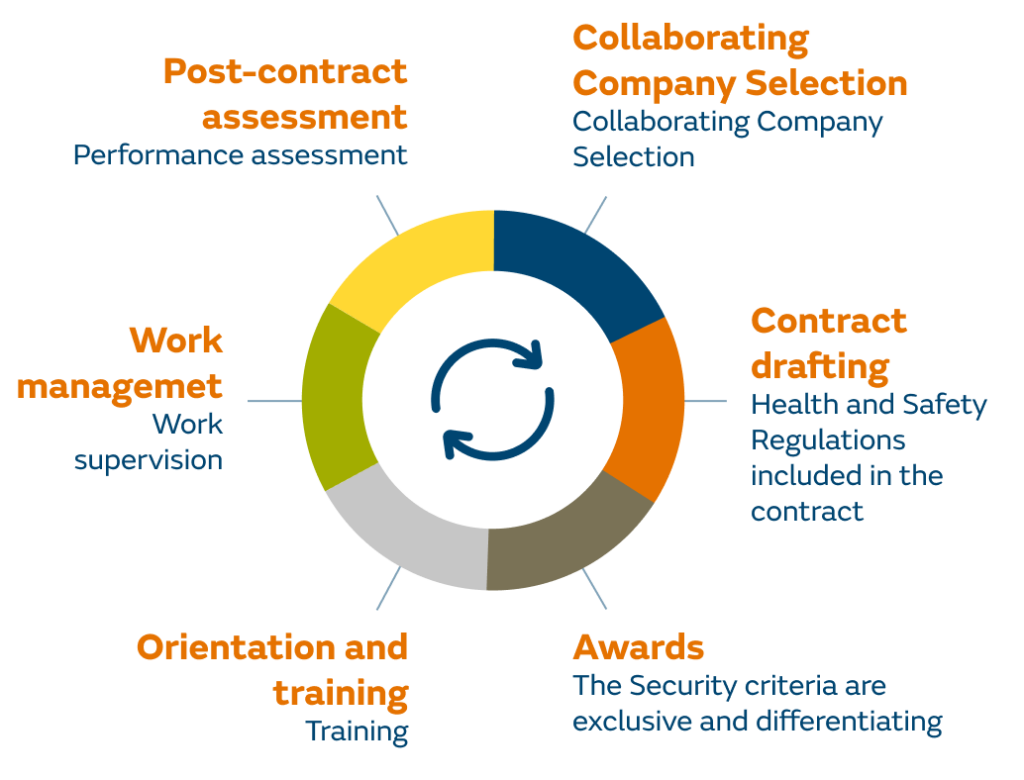Inicio / People / About us / Health, safety and well-being / Health and Safety Commitment
Health and Safety Commitment

Occupational health and safety management system
We have an occupational health and safety management system (SGSST in Spanish) audited and certified by third parties and unique to the whole Naturgy Energy Group, developed in collaboration with all the business units and focused on the most critical risk areas.
Our lines of action
Its scope is global and includes all businesses and countries, revolving around five lines of action:
Leadership
Employees
Partner companies
Safety of processes and facilities
Society
The normal development of the occupational health and safety management system in structured around the following elements:
- Integration of health and safety in the value chain, including the contracting, design and planning of activities and facilities.
- Action plans to address the most critical aspects that ensure the implantation of preventive and/or corrective measures and strategic lines of work.
- Promotion of a healthy work/life balance.
- Adjusting the model to the new ways of working both on-site and remotely to prevent new associated risks.
- Advanced methodologies to manage psychosocial factors in our workplaces.
- Itineraries and training requirements adjusted to workplaces.
- Homogeneous supervision tools to evaluate and monitor risks, legal requirements, accidents and lessons learned, and their dissemination.
- Consultation and participation of workers and their representatives.
- Regular reporting on health and safety performance, adjusted to the needs of the different interested parties, with transparent and clear communication.
- Compliance with pertinent international standards and regulations in the area of occupational health and safety, such as ISO 45001 and the Spanish Association for Standardisation (AENOR).
- A commitment to continuous improvement of the occupational health and safety management system.
- The establishment of quantitative targets to improve occupational health and safety performance, linked to monitoring the evolution of indicators and the action plans derived from incidents and accidents.
The central tenet of Naturgy’s Health and Safety Commitment culture is the involvement and collaboration of company workers. The involvement of workers through consultation and participation in aspects related to health, safety and well-being is essential to identify, rectify and eliminate potential risk situations.
As required by ISO 45001, we guarante adequate internal and external communication, and that it will share the results of the management system review carried out by the directors with the workers’ representatives, and encourage their collaboration in the review and continuous improvement of the management system
There is a corporate standard for the identification, assessment and control of occupational hazards which, among other matters, establishes:
- Guidelines to identify the hazards to which workers may be exposed.
- The methodology to assess the risks.
- Responsibilities associated with implementing these processes and the competencies of the employees taking part in them.
- Participation of workers’ representatives.
- Periodicity.
- Criteria for reporting the results to employees.
- Criteria of the review processes that guarantee their effectiveness.
The health and safety management system implemented at Naturgy includes several lines of action designed to minimise the negative impact of accidents associated with the six most critical risk factors by frequency and severity:

Psychosocial factors
A regular and periodic assessment of the psychosocial factors is performed, identifying areas for improvement and developing effective strategies to eliminate or reduce the associated risks.
We have a unified accident and incident investigation system, the model for which is based on root cause analysis and the Human Factor Analysis Classification Scheme (HFACS) methodology.

The contributions of this model to the reporting and investigation of incidents are:
- It optimises analysis and comparison among business units.
- It facilitates the information collection process and disseminates the lessons learned.
- It allows the root causes to be reached by means of progressive reflection.
- It discriminates between responsibilities and allows for a diagnosis of hierarchical levels
- It facilitates the adoption of measures in the short and medium term, including the review of processes, activities and applicable standards.
The concept of the Precursor of Serious and Fatal Injuries (behaviour or condition that can lead to serious or fatal injuries, if not corrected) is an important shift in the analysis and monitoring of accidents and incidents, the main negative impact of our activity on people, because it involves an even more exhaustive research process and a rapid implementation of the control measures that act on the “precursors”, eliminating them or reducing their impact.

We promote the continuous improvement in health and safety of its Partner Companies, and demands strict control of the critical risk factors relating to the outsourced activity.
It has a security management model for Partner Companies that regulates the entire contracting life cycle.
Promoting continuous improvement
They are not invited to the selection process if they do not meet the health and safety conditions. (<70 points)
They may be de-certified if they do not meet the Health and Safety contract conditions.
We value proactive behaviour with regards to safety by applying positive metrics criteria.
- Incident reporting.
- Implementing safety improvement actions.
Prioritising employee training.
- Demanding individual training certificates
- Verifying legal accreditations where necessary
Applying the penalty system when non-compliance is detected.

We firmly commit to occupational risk prevention, and we recognise that psychosocial factors are a fundamental part of the health and well-being of the people that form part of the company.
To that end, we provide resources and tools that promote the integral well-being of our workers. These include work-life balance initiatives, mental health promotion activities, emotional skills training and stress management tools. We also provide support and guidance to those facing psychosocial challenges, ensuring they have access to the right resources.
Through the continuous assessment of psychosocial risks, we identify areas for improvement and develop collective strategies to eliminate or reduce risks. We work in collaboration with employees and encourage participation in a safe and inclusive environment.
Our commitment to psychosocial factors as a catalyst for the commitment of the entire organisation to society, to its own values and, most importantly, to the health of all its workers.
Medical services coordinate health surveillance medical examinations to detect and prevent possible harm to health due to work-related risks, and to detect any special sensitivity to these risks among workers because of their state of health, or in relation to transitory states of special sensitivity to certain risks, such as pregnancy and lactation.
Where necessary, Health Surveillance, together with the rest of the prevention specialities, suggest the modifications required to adapt workplaces to people with special sensitivity, taking the gender perspective into account.